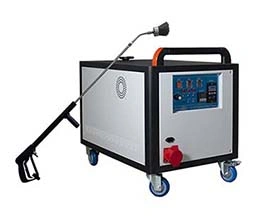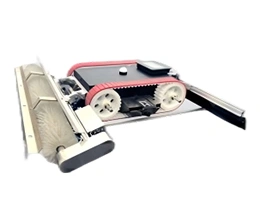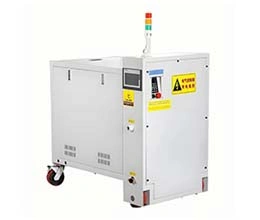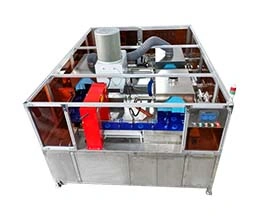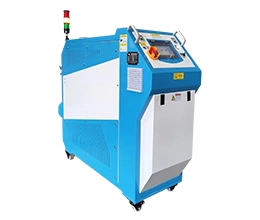What safety measures does the explosion-proof cleaner implement for flammable/explosive environments?
Explosion-proof cleaner uses a specially designed explosion-proof motor to prevent sparks and high temperatures during operation. The explosion-proof enclosure is constructed with durable materials, offering sealing and impact resistance. All critical components undergo special treatment, and every seam/interface features explosion-proof sealing to contain internal electrical faults and prevent spark/heat leakage.
How does the diesel steam cleaner improve cleaning efficiency for heavy oil and grease applications?
The diesel steam cleaner generates high-temperature steam (up to 158–200°C) and high pressure (10–18 bar), quickly softening stubborn grime and oil residues. Steam easily penetrates hard-to-reach areas such as gaps and edges, ensuring thorough cleaning. Moreover, the diesel steam cleaner requires minimal water, significantly conserving water resources.
Can the diesel steam cleaner damage surfaces like walls or delicate materials during cleaning?
The diesel steam cleaner allows users to adjust both steam pressure and temperature based on the surface material, ensuring effective graffiti and stain removal while minimizing the risk of damage. For older or more fragile surfaces, the gentle yet effective nature of diesel steam cleaning is particularly advantageous, as it cleans thoroughly without compromising structural integrity.
How can gas-powered steam cleaners help reduce costs in areas with limited electricity or high energy prices?
Unlike electric models, gas-powered steam cleaners operate independently of power sources, offering greater mobility. In regions where gas is cost-effective, they provide significant savings. These units rapidly heat water to high temperatures required for steam generation, with flowing water instantly vaporizing upon heat absorption. This delivers immediate steam production, high thermal efficiency, reduced energy consumption, and lower operating costs.
How does steam cleaning ensure mite eradication in automotive applications?
Our steam cleaners use adjustable dry/wet steam technology to penetrate gaps, remove particulate grime, and eliminate mites/bacteria through high-temperature sterilization. This chemical-free approach ensures no residue while prolonging equipment lifespan.
The hidden areas of air conditioners, such as condenser fins and air ducts, are difficult to clean thoroughly. How does your AC steam cleaner ensure complete cleaning?
Our steam cleaner for air conditioners uses an instant steam generator with German heating technology, producing 160 °C high-temperature, high-pressure steam in just 10 seconds (pressure up to 15 MPa). The steam instantly penetrates condenser fins and blower wheel gaps. With its dynamic flushing principle, steam impacts dirt at a flow speed of 20 m/s, ensuring thorough cleaning with no blind spots.
How does the solar panel cleaning robot ensure operational safety in PV power plants?
Solar panel cleaning robot features intelligent safety protection, including ultrasonic anti-fall sensors that monitor panel edges in real-time and trigger emergency stops to prevent falls. It also includes over-voltage/over-current/low-voltage/overheat/short-circuit protection for all-weather safe operation.
How does the solar panel cleaning robot adapt to uneven terrain and complex environments in solar farms?
The solar panel cleaning robot integrates sensors for autonomous obstacle avoidance and anti-fall protection. Its track design allows remote-controlled movement (forward/backward/turning), enabling operation on 0°–45° slopes and ensuring thorough cleaning across irregular terrain.
Municipal sanitation cleaning involves heavy workloads. Can electric heated hot water pressure washers operate efficiently while maintaining a long service life?
Yes. The gun body uses aerospace-grade aluminum with anti-corrosion coating and an outer Kevlar reinforcement layer for wear and bend resistance, ensuring a lifespan of 1,000+ hours. The standard high-precision water softener filter employs ion exchange technology to remove calcium/magnesium ions, preventing scale buildup in heating chambers and pipes, thereby extending equipment longevity.
Can a diesel-heated hot water pressure washer handle heavy contamination in ship cleaning applications?
Yes. Operating at 1500-3000 Bar, it tackles industrial-level heavy contamination (e.g., petrochemical coke, ship rust). Its anti-corrosion design (stainless steel pump + ceramic plunger + Teflon seals) ensures resistance to seawater, acids, and alkalis.
Can cold water high-pressure washers handle frequent cleaning tasks with heavy oil and debris in mechanical factories?
Yes. With 200-500 bar pressure range and optional hot water functionality, they efficiently remove oil, scale, concrete, and other stubborn contaminants. Efficiency increases by over 50% compared to traditional methods. Key components (Italian water pump, anti-corrosion gun, high-pressure hose) undergo rigorous testing, ensuring suitability for high-frequency industrial use with a lifespan exceeding 1,000 hours.
How does the tunnel washer ensure stringent cleanliness for aerospace applications?
Tunnel washer for gears employs high-pressure three-stage spray system and stepped cascade water tank design, achieving < 99% oil removal efficiency. Its cleaning performance surpasses traditional equipment, ensuring high-precision gear components meet aerospace-grade standards and eliminating impurities that could compromise operational reliability.
Automotive motor shaft cleaning involves complex, multi-step processes. Can tunnel washer for motor shafts handle the entire workflow in one machine?
Yes. Tunnel washer integrates five core stages – conveying, washing, drying, and wastewater treatment. Shafts enter via conveyor, undergo demagnetization, multi-stage washing, blow-off, and drying, exiting clean and dry for assembly.
Can automatic crate washing machine meet the needs of logistics companies requiring high efficiency and low cleaning costs?
Yes. Crate washing machine integrates pre-wash, main wash, rinsing, blow-drying, and drying into a continuous process, significantly improving efficiency. Independent circulating water tanks enable water recycling, reducing waste. When heating is off, power consumption is only 33KW, minimizing energy costs.
How does the tray washer handle complex stains on food processing trays?
The multi-stage system first uses high-pressure spray to remove heavy grease, then recirculated water for rinsing. 18.5KW pumps ensure 360° coverage, while a final 7.5KW fresh water rinse eliminates residual contaminants, guaranteeing thorough cleanliness.

